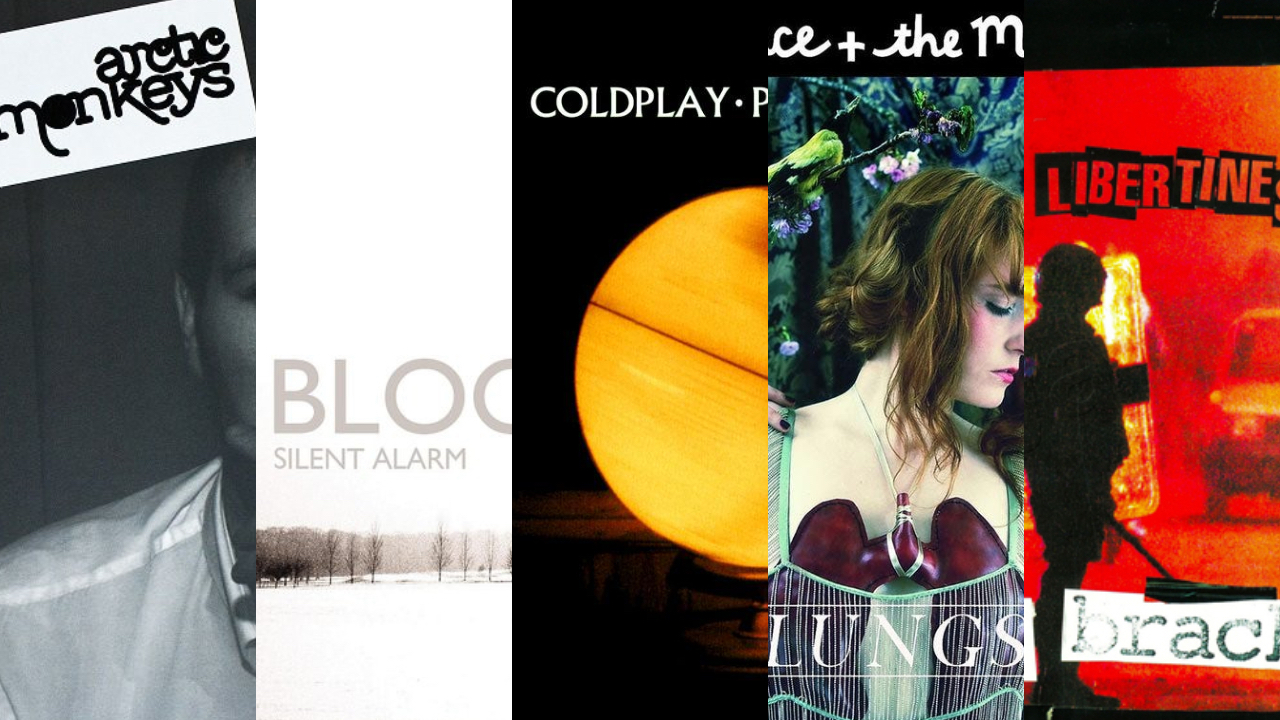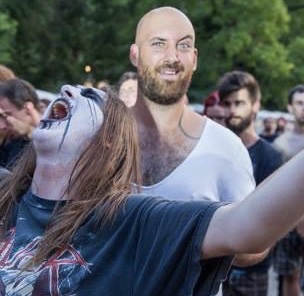The turn of the century was a subdued time for British indie. After any decent knees-up, there’s a hangover, and after Britpop's bouncy in-your-face blokeish-ness began to fade, in came lots of men sitting on stools playing acoustic guitars. This was how indie looked as the 00s begun, defined by meek singer-songwriter-y fare such as Travis, Turin Brakes and David Gray, indie that your uncle who listened to Terry Wogan’s breakfast show every morning could approve of. But then came the calvary, a garage-rock stampede sparked by The Strokes and a wave of exciting young rock’n’roll groups emerging from New York, inspiring a new breed of bands to get their act together in the UK.
It was here that the 00s indie revolution truly began in the UK, the sound of the genre shape-shifting with each fresh arrival: there was a renaissance of post-punk from Franz Ferdinand, The Horrors and Editors, spiky alt-rock by the likes of The Futureheads, The Ordinary Boys and Maximo Park, Art Brut’s arch art-pop, euphoric, soaring anthemic arena conquering tunes from Elbow, Snow Patrol and Doves, another mod-revival from The Enemy and The Courteeners, the dance rock of Kasabian, The Cooper Temple Clause and The Go! Team, folk-rock from Mumford & Sons and Laura Marling and the summery yet sardonic pop of Kate Nash and Lily Allen.
Of course, there was also what came to be defined as the indie landfill, as an army of floppy-haired blokes in skinny jeans and pointy shoes descended on Camden Town to try and make it big. Razorlight, The Kooks, The Rifles, The Pigeon Detectives, The View, The Wombats... the list of depressingly dull bands from that scene could go on and on and on. But to reduce the decade solely to these artists is to do it a massive disservice, By the end of the decade, UK’s indie’s crown had slipped and huge pop and hip-hop stars like Beyonce, Lady Gaga, Jay-Z, Katy Perry and Rihanna were the zeitgeist. But love or loathe the period, you can’t deny it was far more eclectic than many give it credit for. Here is that story represented in five of its biggest and best albums.

Coldplay – Parachutes (2000)
By the end of the 90s, Britpop was dead. In its place came Travis, Embrace, Starsailor and more, sensitive chaps strumming acoustic guitars and making songs that your mum would buy in Sainsbury’s and would make your dad cry when they were played over a montage of England getting knocked out of the World Cup. They were popular, but none of them could hold a candle to Coldplay. The group, who formed at university in London, released their debut album just after their second single Yellow had become something of a pop-culture phenomenon. The album was something more of a slow burn, but once it got going with a seemingly endless supply of massive singles, Parachutes rocketed up the charts. It’s easy to sneer at Coldplay these days, but the slight and instantaneous, yet deceptively complex, songs on this album are a world away in terms of quality of its peers; Trouble, Spies, Shiver and High Speed all shimmer with delicate elegance. It turned Coldplay into global superstars, whilst also helping create the blueprint for every guitar act that aimed themselves toward a career filling arenas or stadiums.
The Libertines – Up The Bracket (2002)
In the aftermath of the success of The Strokes and The White Stripes, the UK wanted nothing more than to have their own version of the garage rock revival. They didn’t have to wait too long before they got the band that arguably became the decade's most definitive indie outfit, even though they were only really active for the briefest of periods, The Libertines unquestionably kickstarted the UK scene in the 2000’s. Having been bumming around Camden for about five years, 2002 saw the band explode in popularity with their debut album. Produced by The Clash’s Mick Jones, Up The Bracket showcased a similar raucousness, rawness and gang-like mentality as Jones’ previous band. The flammable chemistry between dual-frontmen Carl Barat and Pete Doherty, the former classic handsome a rocker and the latter a more sensitive, poetic and troubled enigma, was the key to giving songs like Time For Heroes, Boys In The Band and Vertigo their uniquely chaotic feel. Suddenly a style of music that, in the UK at least, had only really been producing safe, mawkish, acoustic ballads felt dangerous again. They imploded before its follow up had been released, but no matter, Up The Bracket had already changed the game.
Bloc Party – Silent Alarm (2005)
The Libertines inspired a huge sea-change in the UK indie scene, but unfortunately much of it was simplistic and one-dimensional music. Endless three-chord songs about getting wasted and drinking with the lads were becoming all too commonplace. Where Doherty and Barat had plenty of personality, many of what came in their wake lacked anything discernable to differentiate them from 20 other bands. It meant that when Bloc Party arrived, they were a breath of fresh air. Essentially a post-punk band at their core, the London quartet added musical complexities, drummer Matt Tong’s dynamic and explosive playing, electronics and dub bass to the sound of 2000’s indie. But crucially, the thing that set them apart was a far greater emotional depth thanks to frontman Kele Okereke’s exploration of existential dread and the pointlessness and futility of life. Something that was far beyond the capabilities of The Fratellis. Helicopter, Banquet, This Modern Love and She’s Hearing Voices were all career highs for Bloc Party, and for a moment it looked like they would usher in a new and more thought-provoking attitude in the scene. It didn’t quite happen, but Silent Alarm remains a classic.
Arctic Monkeys – Whatever People Say I Am, That’s What I’m Not (2006)
Even in a decade of insanely fast-rising artists, the ascent of Arctic Monkeys was staggering. After gaining a cult following from sharing their music online, the band’s first single proper I Bet You Look Good On The Dancefloor saw them swept up in an unbelievable amount of hype - it carried the song to the top of the charts in 2005. When Whatever People Say I Am... was released two months later, right at the start of 2006, it became the fastest selling debut album in British chart history, shifting over 360,000 copies in its first week. Frontman Alex Turner possessed the kind of incisive lyrical poeticism that had drawn people to singer-wordsmiths such as Morrissey and Jarvis Cocker, his tales of working class, troublemaking and boredom perfectly complimented by his band’s urgent, indie punk bangers. The title track, Fake Tales of San Francisco, Still Take You Home, Mardy Bum... the hype might have been massive, but the tunes were so good that they made the rest of their indie peers look utterly redundant. Ironically, by raising the bar so high, it signalled the beginning of the end for the style.
Florence + The Machine – Lungs (2009)
As the decade drew to a close, the party was winding down. Razorlight and Kaiser Chiefs had gone from headlining festivals to slipping down the bill and indie had started to evolve away from scruffy lads into something folksier and rootsier. The success of artists like Bombay Bicycle Club, Vampire Weekend and Arcade Fire led to an entire aesthetic change in indie. The definitive UK band from this period was unquestionably Florence + The Machine, whose debut album catapulted Florence Welch to stardom. Lungs was the end result of Welch’s frustration of years of plugging away at the music industry and the recent break-up of a relationship. Lungs melded soaring baroque pop, orchestral flourishes, jangly folk and sandpaper rough punk rock into something truly unique. The opening strum of Dog Days Are Over has become iconic, and it’s brilliantly backed up by Howl, Kiss With A Fist, Rabbit Heart (Raise it Up), Cosmic Love and that sublime cover of Candi Staton’s classic early house banger You’ve Got the Love. It was a wild ride, but indie in the 00s ended on a high.

